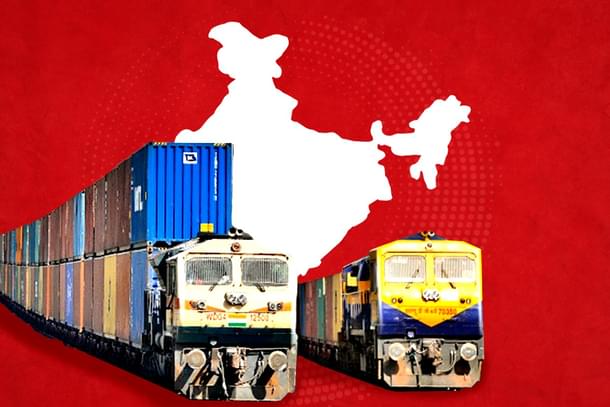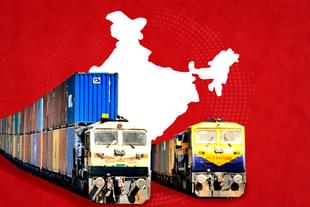Commentary
Freight Surge On Dedicated Freight Corridors Exposes Need For Upgrading Feeder Networks Of Indian Railways: Report
V Bhagya Subhashini
Nov 28, 2024, 02:34 PM | Updated 02:34 PM IST
Save & read from anywhere!
Bookmark stories for easy access on any device or the Swarajya app.


India envisioned the Dedicated Freight Corridors (DFCs) as a revolutionary step to enhance freight transport efficiency and alleviate congestion on its overstressed railway network.
The Golden Quadrilateral (GQ) route, which connects Delhi, Mumbai, Chennai, and Howrah along with its diagonals (Delhi-Chennai and Mumbai-Howrah), handles nearly 58 per cent of Indian Railways’ revenue-generating freight traffic.
However, with line capacity utilisation on the GQ soaring between 115 per cent and 150 per cent, the system was in dire need of a solution. The DFCs have emerged as that game-changer, steadily shifting freight traffic away from the conventional railway network.
Prime Minister Narendra Modi inaugurated the DFC network on 12 December 2020, hailing it as a game changer for India in the 21st century and a catalyst for rapid national development.
The DFC project is strategically aligned with the National Rail Plan, which sets a bold objective: to increase the railway's modal share in India from the existing 28 per cent to an impressive 44 per cent by the year 2051.
Crucially, the DFC is not just a railway project; it's a linchpin of the National Logistics Policy, aiming to reduce logistics costs from the current 15 per cent of GDP to a more sustainable 8 per cent by 2030.
Furthermore, the DFC's capacity expansion is instrumental in realising Indian Railways' ambitious objective of achieving a freight loading capacity of 3,000 MT by 2030.
In a recent study conducted by the University of New South Wales (UNSW) in Australia, India’s Dedicated Freight Corridors (DFCs) are projected to boost the country’s GDP by Rs 16,000 crore.
Emergence of DFCs and Traffic Shift
The Eastern DFC spans a length of 1,337 km, while the Western DFC covers an extensive 1,506 km, creating a comprehensive network. The operationalisation of key DFC sections has accelerated the transition of freight traffic to these specialised corridors.
According to a senior official from the Dedicated Freight Corridor Corporation of India Ltd. (DFCCIL), approximately 90 per cent of freight traffic along the Eastern Dedicated Freight Corridor (EDFC) has moved to DFCs, translating to about 90 trains daily, close to the corridor’s capacity of 100 trains.
Similarly, the Western Dedicated Freight Corridor (WDFC) has seen a 60 per cent-70 per cent shift in freight traffic.
As per Economic Times report, From April to October 2024, the DFCs handled 62,282 million net tonne kilometers (NTKMs), averaging 291 million NTKMs per day—an increase of over 59 per cent from the 182 million NTKMs daily average in FY23-FY24.
The number of daily trains running on the EDFC and WDFC combined has risen from 241 in FY24 to 339 during the same period, showcasing the corridors’ growing significance.

Modern Infrastructure Meets Old Challenges
The EDFC stretches from Sahnewal in Punjab to Son Nagar in Bihar, paralleling the Indian Railways (IR) network, while the WDFC runs from Dadri (Uttar Pradesh) to the Jawaharlal Nehru Port Authority (JNPA) in Mumbai.
These corridors cater to distinct cargo types—EDFC focuses on bulk commodities such as coal, iron, steel, and fertilizers, whereas WDFC primarily handles containerised cargo, petroleum products, and trucks-on-train services.
A crucial advantage of DFCs is their speed. Freight trains on DFC tracks average 60 kmph compared to just 25 kmph on the Indian Railways network.
This has significantly reduced transit times: for example, coal transportation over 100 km takes 4 hours on the DFC compared to nearly 8 hours on the IR network. This enhanced speed is particularly beneficial for industries like power generation, where timely coal delivery is critical.
However, integrating the DFCs with the existing IR infrastructure poses challenges. Freight often originates from locations that rely on conventional IR tracks to reach DFC entry points.
For instance, cargo from Gurgaon to Mundra Port must traverse the IR stretch to Rewari before joining the DFC network. This reliance on IR feeder routes and sidings—many of which require upgrades—limits the DFCs’ potential.
Infrastructure and Capacity Gaps
The DFCCIL has emphasised the need to upgrade feeder routes and railway sidings to DFC standards. Currently, wagons on the IR network are limited to 67 tonnes, while the DFC allows up to 80 tonnes.
Similarly, the DFC supports double-stacked container trains, but many IR stretches have overhead electric wires too low to accommodate such loads. Without these upgrades, the DFCs’ advantages remain partially unrealised. The speed and capacity gains on DFCs are often negated when trains must switch to slower, lower-capacity IR tracks.
Industry and Private Sector Involvement
State-owned Container Corporation of India Ltd. (CONCOR) is among the key beneficiaries of the DFCs. With plans to launch double-stack container trains from Dadri to Vadodara, CONCOR aims to transport 180 containers in a single journey, significantly reducing costs and transit times.
To optimise operations, DFCCIL is developing 22 dedicated terminals along the DFC network and is inviting private players to establish Gati Shakti terminals. By creating these independent terminals, DFCCIL can control end-to-end freight movement, bypassing the slower IR network entirely.
The Road Ahead
The DFCs represent a critical step toward modernising India’s rail freight system, but challenges remain. High-density feeder routes, such as those connecting NCR to Rewari and Ludhiana to Rewari, need urgent upgrades to align with DFC standards.
Meanwhile, operational inefficiencies, such as delays during driver changeovers, crew shortages, and bottlenecks at IR-DFC exchange points, must be addressed to ensure seamless transit.
The Ministry of Railways is actively working on these upgrades, but progress is slow. Experts suggest that modernising rail transit planning and enhancing coordination between IR and DFC operations will be essential to maximise the corridors’ benefits.
V Bhagya Subhashini is a staff writer at Swarajya. She tracks infrastructure developments.





